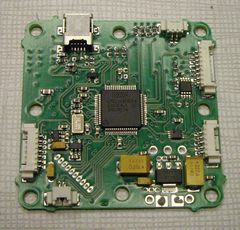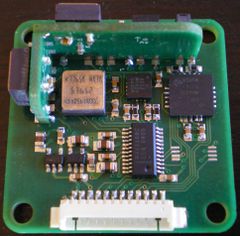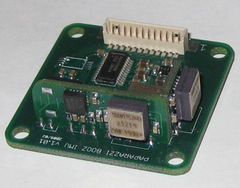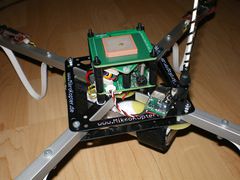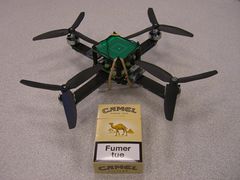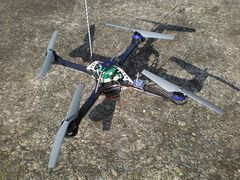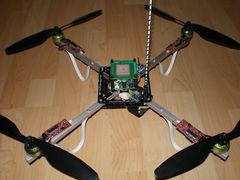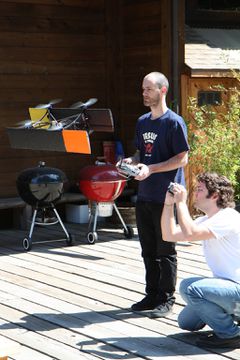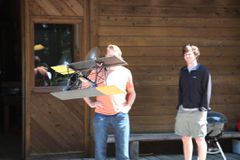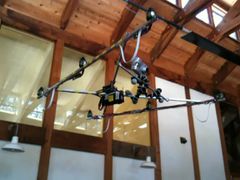Difference between revisions of "Booz"
| Line 217: | Line 217: | ||
the ''max1168'' is the 16 bits analog to digital converter chip used on the IMU to sample gyros and accels. | the ''max1168'' is the 16 bits analog to digital converter chip used on the IMU to sample gyros and accels. | ||
make AIRCRAFT=BOOZ2_A1 test_max118.upload | make AIRCRAFT=BOOZ2_A1 test_max118.upload | ||
== Sensors Calibration == | == Sensors Calibration == | ||
Revision as of 11:46, 14 November 2009
Overview
Booz is an attempt at extending paparazzi to VTOLs. At the current stage of the project, the system provides satisfying attitude control (auto1), vertical guidance and is able to more or less navigate autonomously. It is able to use simple paparazzi flight plans ( only go instructions ) and uses paparazzi telemetry and datalink, which means you can use all the paparazzi ground segment applications ( plotter, settings, gcs, etc...)
The current autopilot consist in 3 boards
- The main board, comprising power supply, a LPC2148 and a barometer.
- The imu board, comprising gyrometers, accelerometers, magnetometers and a 16 bits ADC.
- The GPS board, using a LEA-5H by ublox
It flies on a variety of quadrirotor platforms
and less common vehicles
Where does it reside ?
Everything is at savannah.
-hardware in paparazzi4/trunk/hw/booz -code in paparazzi3/trunk
Assembled hardware is available soonish from ppzuav
Running a simulator
Quick start guide
Booz contains a sensors model and can use Jsbsim to allow arbitrarily complex flight dynamic models.
- Extract a copy of paparazzi3 svn
svn co svn://svn.savannah.nongnu.org/paparazzi/paparazzi3/trunk paparazzi3
- Install all required dependancies
apt-get install paparazzi-dev libtool
- Compile JSBSIM
cvs -z3 -d:pserver:anonymous@jsbsim.cvs.sourceforge.net:/cvsroot/jsbsim co -P JSBSim cd JSBSim ./autogen.sh ./configure --enable-maintainer-mode --enable-compile-warnings --enable-libraries --enable-shared --prefix=/opt/jsbsim make sudo make install
Here is a patch to silent warnings. Also be sure automake and autoconf are installed. If not sudo apt-get install automake autoconf
- Compile paparazzi
cd paparazzi3/trunk make
- Compile the vehicle
make AIRCRAFT=BOOZ2_A1 clean_ac sim
- Start paparazzi_center if you want click to start programs
./paparazzi
- Start messages to monitor the middleware activity ( from the tool menu of paparazzi center) or with
./sw/ground_segment/tmtc/messages
- Start the sim
LD_LIBRARY_PATH=/opt/jsbsim/lib ./var/BOOZ2_A1/sim/simsitl
You should now see activity in the "messages" window
- Plot the value of a message field.
start 'plotter' ( from the tool menu of paparazzi center) or with
./sw/logalizer/plotter
for example drag the label 'int32 phi' from the BOOZ2_FP message to the drawing area of the plotter
- Use the datalink to change the temetry mode
start 'settings' ( from the tool menu of paparazzi center) or with
./sw/ground_segment/tmtc/settings -ac BOOZ2_A1
start 'server' to dispatch datalink messages ( from the tool menu of paparazzi center) or with
./sw/ground_segment/tmtc/server
change the field "telemetry" on the first page to "Att loop" and send by pressing the green check button. THe label on the left or the drop box should change to "Att loop" confirming your essage has been received. "message" should now show that the message "BOOZ2_STAB_ATTITUDE" is received
- Use flightgear to visualize your vehicle
If you want a view of a quadrotor in flightgear, make a link from
/usr/share/games/FlightGear/Models/Aircraft/paparazzi to PAPARAZZI_SRC/conf/simulator/flightgear/
start flighgear with
fgfs --fdm=null --native-gui=socket,in,30,,5501,udp --prop:/sim/model/path=Models/Aircraft/paparazzi/mikrokopter.xml
restart your simulator with
LD_LIBRARY_PATH=/opt/jsbsim/lib ./var/BOOZ2_A1/sim/simsitl --fg_host 127.0.0.1
- Save you session
Tunning the attitude control loop
Here we are going to use the simulator to demonstrate a way of tunning the attitude control loop.
- Restart your previous session
- Set telemetry mode to "Att loop"
- Display two real time plotter windows
In the first one, plot the field "m_phi" from the "BOOZ2_STAB_ATTITUDE" message. This is our estimation of roll angle. On top of that, plot the field "phi" from the "BOOZ2_STAB_ATTITUDE_REFERENCE" message. This is our reference roll angle, that is, the roll value we are trying to achieve.
In the second plotter, plot the fields "delta_a_fb" and "delta_a_ff". Those are respectively the feddback and feedforward part of our roll command. The sum of those two terms is what is used as roll command.The feedforward part is the part used to follow our trajectory and the feedback part is the part used to reject perturbations.
- In "Settings", go to the "Att Loop" tab
We notice that the vehicle doesn't follow accurately the step trajectory we are trying to make him do.
Start by setting the value of the proportional gain ('pgain_phi') to 1000 instead of 400. The vehicle now follows the trajectory faster but overshoots. To prevent that, increase the value of the derivative gain ('dgain p') from -300 to -700.
If you look at the plotter where you're ploting the commands, you'll notice that during steps, the feedback command has to work hard. This means that our feedforward command is badly tunned, and namely not working hard enough.Increase the value of the feedforward gain ('ddgain p') from 300 to 540. You'll notice that now the feedback command has becomed marginal during the steps. This is the right value for the gain. Anything bigger will make the feedback command fight against the feedforward command during steps, anything smaller will make the feedback command have to complement the feedforward command.
Something else
- try starting flightgear with
fgfs --fdm=null --native-gui=socket,in,30,,5501,udp --prop:/sim/model/path=Models/Aircraft/paparazzi/simple_bipe.xml
an the sim with
LD_LIBRARY_PATH=/opt/jsbsim/lib ./var/BOOZ2_A1/sim/simsitl --fg_host 127.0.0.1 --rc_script 1
Hardware Test
Booz comes with a number of simple test programs that you can use to validate a newly assembled board or learn how booz code works in case you want to extend it. The Makefile for those is in conf/autopilot/booz2_test_progs.makefile
test_downlink
Paparazzi's Makefile allow you to build different TARGETS (aka programs) using a doted notation. The begining of the Makefile reads
#
# test downlink
#
test_downlink.ARCHDIR = $(ARCHI)
test_downlink.ARCH = arm7tdmi
test_downlink.TARGET = test_downlink
test_downlink.TARGETDIR = test_downlink
#
test_downlink.CFLAGS += -DBOARD_CONFIG=$(BOARD_CFG) $(BOOZ_CFLAGS)
test_downlink.CFLAGS += -DPERIPHERALS_AUTO_INIT
test_downlink.srcs += $(SRC_BOOZ_TEST)/booz2_test_downlink.c
test_downlink.CFLAGS += -DUSE_LED
test_downlink.CFLAGS += -DPERIODIC_TASK_PERIOD='SYS_TICS_OF_SEC((1./10.))' -DTIME_LED=1
test_downlink.srcs += sys_time.c $(SRC_ARCH)/sys_time_hw.c $(SRC_ARCH)/armVIC.c
#
test_downlink.CFLAGS += -DUSE_UART1 -DUART1_BAUD=B57600
test_downlink.srcs += $(SRC_ARCH)/uart_hw.c
#
test_downlink.CFLAGS += -DDOWNLINK -DDOWNLINK_TRANSPORT=PprzTransport -DDOWNLINK_DEVICE=Uart1
test_downlink.srcs += downlink.c pprz_transport.c
FIXME: More on this when syntax highlighting/line numbering works
The command line to compile the "test_downlink" target for the BOOZ2_A1 aircraft would be
make AIRCRAFT=BOOZ2_A1 test_downlink.compile
and to upload this program to your board ( you don't really need to type the previous command, make is smart and will compile your program if needed when you ask him to upload it )
make AIRCRAFT=BOOZ2_A1 test_downlink.upload
test_max1168
the max1168 is the 16 bits analog to digital converter chip used on the IMU to sample gyros and accels.
make AIRCRAFT=BOOZ2_A1 test_max118.upload
